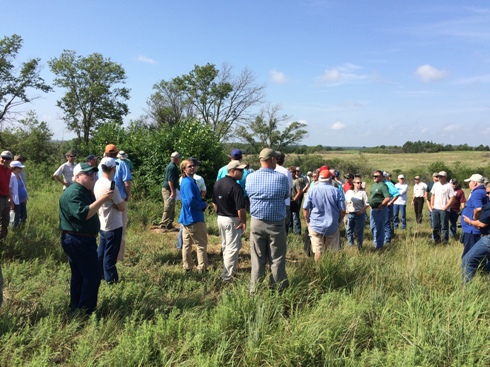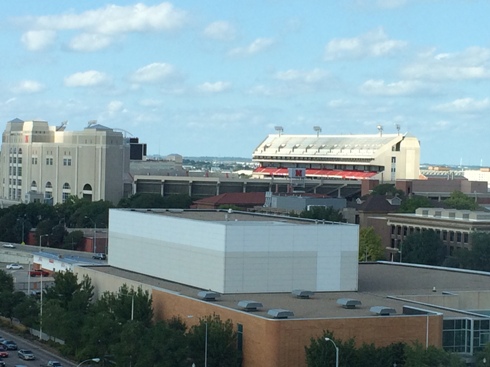Next month I promise to return to a topic that may be educational, useful and less philosophical – expressly quail nutrition and food habits. But this month, I wanted to share a few thoughts from the heartland after our recent National Bobwhite Technical Committee meeting in Lincoln, Nebraska.
I have visited the “plains states” several times and I love it “out there.” Some folks refer to the heartland as the “flyover states,” insinuating there’s nothing there to interest anyone not from around there. And from 35,000 feet you see lots of squares and circles representing crop fields, and very few homes or towns. On the ground one of the first things I felt was that there’s very few places to hide from the weather … or hide from anything else for that matter. And it has created a people without pretenses. More than anywhere I have ever visited, it is a place where “what you see is what you get,” take it or leave it.
In winter the wind is relentless, as well as the work … and it leaves little time for fanciness. Homes look worn, but the people in them don’t and in every country café I visited, people were friendly and welcoming. “You guys bird hunting?” would be a frequent question as we sat eating fresh hamburgers. Often followed by something like “Well, if you get over by Clay Center, I have a piece of land there you are welcome to hunt.”

I remember back in 2008 registering for a hotel one evening in Clay Center and I asked the lady behind the desk “What county are we in?” She looked at me like I was about the stupidest hunter she ever saw and said, “Why do you think they call this town Clay Center?” That’s when it hit me, most everything was surveyed in squares on the plains, and each square county had a town surveyed and laid out right at its center…hence Clay Center was at the geometric dead center of Clay County. When you are from the convoluted Southeast like me, there is something refreshing about that simplicity.
And not to disparage our Nebraska friends, but some things regarding quail are just easier out there than they are here. For starters, it’s rural, and that alone makes life easier for quail and all sorts of other critters. I am talking so rural in places that on our field tour last week the tour buses just parked right in the road while we went about our guided stops. And if a car did come along, they’d just go around us (maybe one or two cars all afternoon).
Next, farmland out there is everywhere – there is so much of it that it makes it easier not to farm every acre of it, and that again helps the bobwhite along with many plants and animals. Perhaps most importantly – it takes trees years and years to grow out there once any distance from a waterway. Sweetgum there is found in a pack, not growing from the ground. Red maple? Pine? Poplar? Not there. Plant succession is slow and thus the need for active management is not quite as urgent as it is here in the humid East. Another little something I noticed, non-native invasive vegetation has not had nearly as long to take hold out there as it has back here. It exists and does cause problems, but the native seedbank of plants seems to respond fairly well when given a chance. Wild plum still seems to grow on its own there, too, and I saw many a good thicket of it along roadsides, much like Kansas back in 1997 when we did not really need a bird dog to find quail. We simply hopped from plum thicket to plum thicket relying on the dogs mainly to help us chase the birds out (those quail would run around and around in circles within those thickets hating to fly out).
They have their share of problems, too, and I don’t want to make it sound easy. Winters can be severe, drought can have negative effects and as the human population increases they’ll be expected to squeeze every soybean out of their farmland. But it is nice to know that given good weather, a little passive neglect and some active management with fire and cattle grazing can still produce a bunch of bobwhites somewhere in America.

Also, in my opinion, if you have never visited our plains states, you can’t really call yourself an American or a bird hunter. If for no other reason, you need to drive out there during winter, stand out
in the middle of that vastness and appreciate the kind of self-sufficiency and courage it takes to live there.
Ah, yes, and about the NBTC meeting itself…it was fantastic (Thanks Nebraska folks!). I left once again feeling like the NBCI was on the verge of great things. Their list of accomplishments over the past year is impressive. There have been doubters out there and concerns expressed about the use of Pittman-Robertson funds to support NBCI staff.
As I sat looking out my hotel room, I had a magnificent view of the Nebraska Cornhuskers football stadium. A more famous stadium one will be hard pressed to find. The Big Red is everywhere in Nebraska. I thought about how the NBCI had only existed for six years and had only had stable funding for two years and it made me think to myself “I wonder where Nebraska would be if they’d given up on their football team after its first two years?”
The kind of work ethic and dedication I see in Nebraska fans is evident all over our great country, it is what makes us great, and I see it exemplified by the staff of the NBCI.


